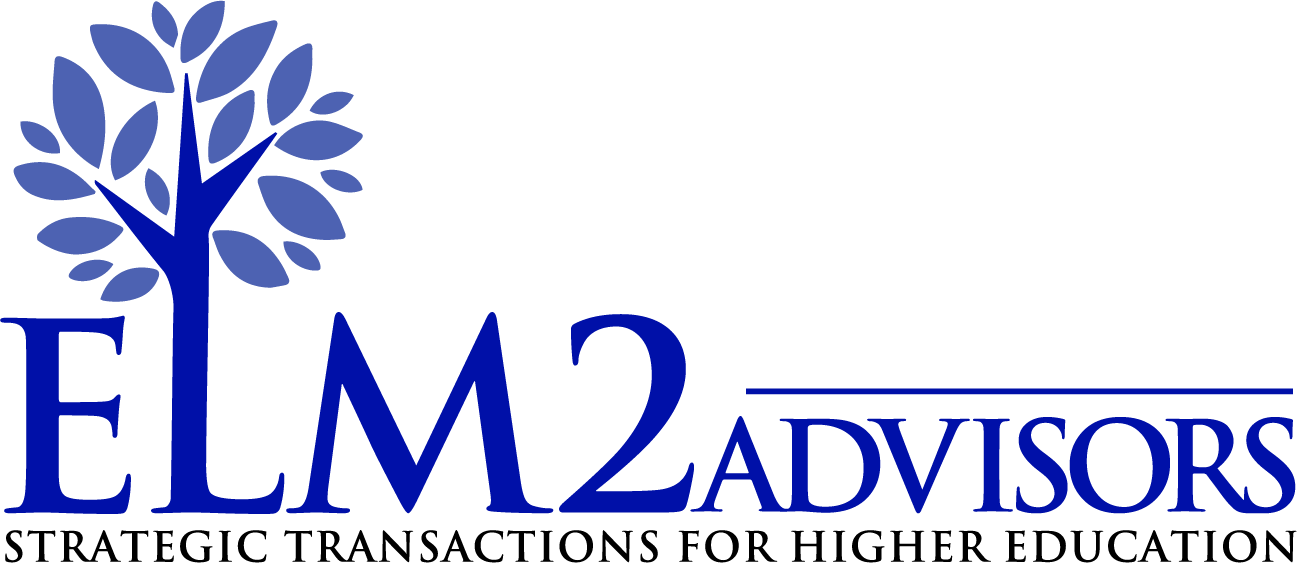Elmore R. Alexander, Ph.D.
Larry E. Penley, Ph.D.
February 2022
In the dynamic world of higher education there is much talk about financial failures and mergers of institutions that are in financial difficulty. How do presidents and boards to trustees sort out the status of their institution? Is there an opportunity for a strategic acquisition that they should be considering? Should they be looking for an opportunity to merge with a more financially sound institution? From our perspective, institutions that should be considering a strategic acquisition opportunity fit into three groups:
1 – Financially challenged institutions
Financial failure has been a rare occurrence in the history of US higher education. Most prognosticators do not expect this to be the case in the future. In a recent survey by the National Observer, 38 out of 52 private colleges experienced declines in student revenue during AY 2021.[1] According to data from the National Student Clearing House Research Center, enrollment fell another 3.2 percent in the fall after falling 3.4 percent last year.[2] Last year, despite tuition revenue decline and lost revenue from ancillary services like food and housing, an institution’s finances may have looked somewhat better. In many cases, they were propped up by Covid assistance funds as part of the two federal pandemic relief packages. Overall enrollments are down, and it is likely that the financial crisis that many predicted at the start of the pandemic will come to fruition this spring.
Potentially failing academic institutions face three problems. The first problem is the costs of nonacademic operations. The costs of these operations (business and finance, admissions, student services, and information technology) have increased substantially in recent years. The level of competition in admissions, for example, continues to increase with the introduction of sophisticated and expensive social media recruitment strategies. Likewise, the cost of developing and marketing on-line programs demands increasingly sophisticated and expensive instructional design, social media, and information technology professionals. Trying to spread these and similar costs across a stagnant or shrinking student population is impossible. The result for many institutions is that the costs of their nonacademic operations are skyrocketing while the effectiveness of those operations is decreasing. This is not sustainable.
The second problem is an overinvestment in nonrevenue producing assets. One of our partners detailed these problems in a blog entitled “Too Many Buildings, Not Enough Bandwidth.”[3] Many universities are sitting on substantial amounts of land that are less than fully utilized. Similarly, shifts to on-line and technology enhanced instruction are likely to change the traditional shortage of space on campus to a surplus. In times of financial crisis, it is hard to tolerate unproductive assets.
The third problem is underperforming academic programs. Everyone knows that most institutions have programs with insufficient enrollments to justify the faculty and operational costs associated with them. Furthermore, there are significant inefficiencies in program delivery. These include low enrollment in course sections, inefficient use of instructional technology, and scheduling bottlenecks that stifle student progress. These problems increase the cost of instruction and decrease enrollments as they encourage students to “drop out” or “stop out” thereby causing retention to decrease. Historically, these have been difficult issues for institutions to address.
Institutions with these three sets of problems are ripe candidates for acquisition. Without both structural changes and an influx of investment capital, these institutions cannot survive.
2 – Status Quo Institutions
Status Quo Institutions are not in immediate danger of closing. They face many of the same problems faced by the Financially Challenged Institutions. They are probably running at a financial deficit, have done so for the last several years, and project deficits into the near future. They have reserves (endowment and funds acting as endowment) to keep them running. They do not, however, have sufficient funds to grow or to thrive in the current environment. Each of the problems, therefore, represents an opportunity for them.
- They need to reduce nonacademic costs and improve the effectiveness of nonacademic operations.
- They need to find new uses for or shed nonproductive assets.
- They need to increase the efficiency and effectiveness of academic programs.
- They need a strategy to expand program offerings especially in online instruction.
They do not, however, have the financial resources to make these changes and investments. Thus, they are a candidate ripe for a partnership or merger with a financially sound institution.
3 – Financially Sound Institutions
While Financially Sound Institutions face the problems described above to some degree, they are also positioned to see these issues as an opportunity for a potential partnership or merger. These institutions have developed administrative strengths and efficiencies in the areas of student services, business and finance, admissions, and the use of technology especially in online education. Additionally, they have distinctive/niche programs that be added to the portfolio of another institution. Finally, these institutions need to be able to expand their markets beyond those that they have traditionally served.
These institutions are well positioned to look for institutions with whom to partner or to acquire. They would be in the position to reduce the administrative costs of the other institution by taking over certain administrative functions such as admissions and information technology. They would be in the position to invest in the development of complimentary programming at the other institution. They would be able to place their own niche programs at the other institution bringing their programming to new markets.
Where do you go from here?
It is not easy to navigate the waters of strategic acquisitions in higher education. This is not the job for which most higher education executives trained. The situation is no easier for board members—strategic acquisitions in higher education look nothing like those in the corporate world. We set up ELM2 Advisors to bridge this gap—combining a knowledge of the business realities of strategic acquisitions with a deep understanding of the peculiar dynamics of higher education.
Elmore R. Alexander is a partner in ELM2 Advisors and a current member of the Governing Board of Les Roches International School of Hotel Management (Switzerland). He is the former business school dean at Marist College, Bridgewater State University and Jefferson University.
Larry E. Penley is a partner in ELM2 Advisors, a current board member and the previous chair of the State of Arizona Board of Regents, and member of the Board of Directors of the Glion Institute of Higher Education (Switzerland). He is also the former president of Colorado State University and Thunderbird School of International Management and the dean of the W.P. Carey School of Business at Arizona State University.
[1] https://www.bizjournals.com/bizjournals/news/2022/01/06/university-student-revenue-declines-2021.html?utm_source=st&utm_medium=en&utm_campaign=tno_he&ana=e_tno_he
[2] https://www.npr.org/2021/10/26/1048955023/college-enrollment-down-pandemic-economy
[3] https://blog.optimal-partners.com/articles/many-buildings-not-enough-bandwidth/


